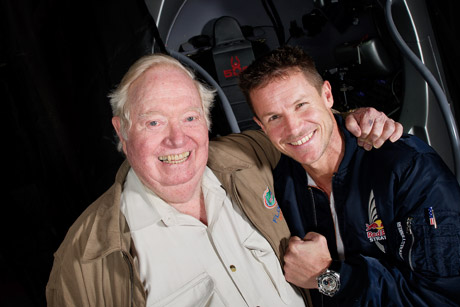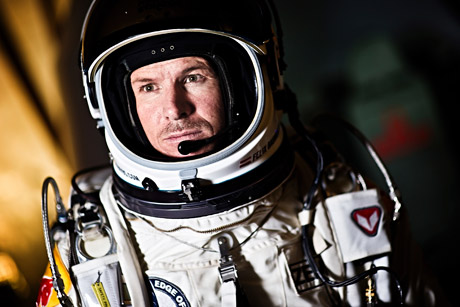SKI.BG > SKI in Bulgaria - http://www.ski.bg
. sport : Red Bull Stratos: Then and now - 12 October 2012 - 20:12
A Comparison of Two Extraordinary Missions
RED BULL STRATOS. On August 16, 1960, Joe Kittinger’s Excelsior III mission opened the way for manned space flight. In 2012, Felix Baumgartner hopes to take stratospheric freefall to new levels, including supersonic speed. Much has changed – but the hazards of the stratosphere remain the same.

USAF colonel (ret.) Joe Kittinger of the United States and pilot Felix Baumgartner of Austria seen during the presentation of the capsule for Red Bull Stratos, a mission to the edge of space to break the speed of sound in freefall in Lancaster, California, USA on February 23 2012. Photo Credit: Jörg Mitter/Red Bull
The Altitude:
Joe jumped from a height of 102,800 feet.
Felix intends to jump from a height of 120,000 feet.
The Unknowns:
In 1960, no one knew if a human being could survive a jump from the edge of space.
In 2012, no one knows if a human being can survive a supersonic freefall.
The Men:
Joe Kittinger, a 32-year-old Florida native, was a Captain in the U.S. Air Force, was a fighter pilot and test pilot, and had his gas and hot air balloon ratings. He had already piloted a balloon to 97,000 feet. Excelsior III was his 33rd parachute jump.

USAF Colonel Joe Kittinger seen prior to his world record setting jump from 102.800 feet during the Excelsior III program at Holloman Air Force Base, Alamogordo, New Mexico, United States on August 16 1960. (U.S. Air Force Photo). Photo Credit: National Museum of the US Air Force/Red Bull
Felix Baumgartner, born in Austria in 1969, is a record-setting skydiver and BASE jumper and former member of a military skydiving team. A licensed helicopter and gas balloon pilot, he has made 2,300+ skydives and was first to cross the English Channel using a carbon wing.

Pilot Felix Baumgartner of Austria seen during the first manned flight for the Red Bull Stratos mission in Roswell, New Mexico, USA on March 15 2012. Photo Credit: Jörg Mitter/Red Bull
The Programs and Goals:
Excelsior III was a U.S. Air Force program with scientific aims to benefit U.S. aerospace research. The mission team hoped to test parachute, pressure suit and other equipment.
Red Bull Stratos is a private program with scientific aims to benefit international aerospace research. As part of researching unprecedented extremes, Felix Baumgartner has made it a goal to try to become the first person to break the speed of sound in freefall, which could provide valuable data for future aerospace missions.
The Teams:
Joe Kittinger was supported by an expert team of U.S. Air Force scientists, researchers and medical personnel.
Felix Baumgartner is supported by an expert team of international scientists, researchers and medical personnel, including Joe Kittinger himself.
The Equipment:
Much of the equipment used by Joe Kittinger for Excelsior III was “off the shelf,” or modified off-the-shelf components.
Almost none of the equipment being used by Felix Baumgartner is “off the shelf.” Most components have been specially made or modified.
Pressure Suit:
Joe Kittinger wore a U.S. Air Force standard partial-pressure suit that used capstans (rubber tubes inflated to tighten the suit around the body).
Felix Baumgartner will use a custom-made full-pressure suit. Manufactured by David Clark Company, the suit is based on models used by pilots of high-altitude reconnaissance aircraft, but has been modified with increased mobility and other enhancements.
Balloon:
Joe ascended via a 3 million cubic foot helium balloon made of polyethylene. It was launched from the back of a truck.
Felix is ascending via a helium balloon with a capacity of nearly 30 million cubic feet, made of polyethylene. It will be launched using a large crane.
Vessel:
Joe Kittinger ascended in an open, unpressurized gondola, which required his suit to be inflated throughout the ascent as well as the descent.
Felix Baumgartner will ascend in a pressurized capsule, and if all goes according to plan he will not have to pressurize his suit until he has reached jump altitude.
Parachutes:
Joe had three types of chutes in his rig: a main parachute, a reserve parachute and a drogue stabilization chute. Joe’s main and reserve parachutes were standard for military use at the time. His drogue was not designed for supersonic speed. Joe’s drogue chute and main chute were triggered automatically by a system that incorporated a timer and an altitude sensor.
Felix will have three types of chutes: a main parachute, a reserve parachute and a drogue stabilization chute. Felix’s main and reserve parachutes are a ram-air design somewhat similar to those used by pro skydivers. Felix’s drogue is uniquely designed to function at supersonic speeds; however, it will not be deployed unless he needs it for stabilization. Felix’s main chute does not have an automatic deployment feature (but his reserve parachute does).
The Technology:
Excelsior III used the best technology available at the time. Joe communicated with the ground via radio in the capsule. His initial step-off from the gondola was recorded on film. Scientific data captured included heart rate, respiratory rate and acceleration data. Data was shared with U.S. research personnel for development of the space program.
Red Bull Stratos uses the best technology known, creating solutions where they aren’t available. Felix will communicate with the ground via radio from the capsule and a transmitter in his chest pack. The entire mission will be recorded by moving-image and still cameras. The team intends to share findings with the aerospace research community.
Transmission:
Joe’s Excelsior III mission was not made public until the jump was successfully completed.
Felix’s Red Bull Stratos mission will be followed in real time around the world.
Preparation:
Joe had completed more than 100 tests in an altitude chamber and a cold chamber and kept in shape by running and playing racquetball and tennis.
Felix’s multi-stage test program encompasses training in an altitude chamber, a cold chamber and a wind tunnel, as well as conducting successively higher jumps from helicopters, airplanes and balloons. Felix also works with a high performance director to hone his readiness.
Descent Time:
It took Joe Kittinger 13 minutes, 45 seconds to descend to Earth.
It is estimated that it will take Felix Baumgartner 15 to 20 minutes to return to Earth.
Retrieval:
Joe was located for retrieval visually, by a helicopter.
Felix will be tracked and retrieved via a GPS system in his chest pack, as well as through visual monitoring from the ground and aircraft.
Records:
Speed/First to Break the Speed of Sound in Freefall
- Joe Kittinger accelerated to 614 miles per hour, equivalent to Mach 0.9.
- Felix Baumgartner intends to become the first person to break the speed of sound and achieve Mach 1 in freefall, estimated to be at least 690 miles per hour.
Freefall from Highest Altitude
- Joe Kittinger jumped from an altitude of 102,800 feet.
- Felix Baumgartner expects to jump from 120,000 feet.
Longest Freefall Time
- Joe Kittinger was in freefall for 4 minutes, 36 seconds.
- Felix Baumgartner is expected to be in freefall for 5 minutes, 35 seconds or more.
Highest Manned Balloon Flight
- Joe Kittinger ascended to an altitude of 102,800 feet (the only one of his records that has been surpassed – the current record is 113,740 feet).
- Felix Baumgartner expects to ascend to an altitude of 120,000 feet.
Red Bull Stratos
12.Oct 2012
[xt] ski
Return


